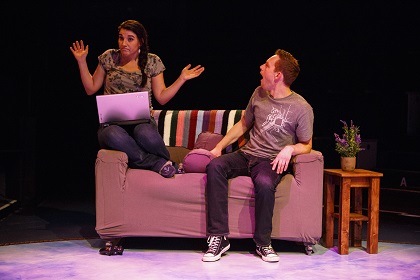 Regina audiences are the latest to enjoy Salt Baby, which was featured on the Globe Theatre’s mainstage from January 18 to February 5. This is the second time the play was shown in Regina—it was part of the Shumiatcher Sandbox Series, also at the Globe, in 2015. In the two years since, the play has come a long way, both geographically and artistically.
Regina audiences are the latest to enjoy Salt Baby, which was featured on the Globe Theatre’s mainstage from January 18 to February 5. This is the second time the play was shown in Regina—it was part of the Shumiatcher Sandbox Series, also at the Globe, in 2015. In the two years since, the play has come a long way, both geographically and artistically.
“The Globe team created a design that allowed us to tour, and the Globe most graciously loaned us the whole thing to take to the Talking Stick Festival in Vancouver,” says Yvette Nolan, director of Salt Baby. At that festival, presenters from the Yukon saw the show and asked for it to come to their communities. A Culture on the Go grant from the Saskatchewan Arts Board enabled the production to tour to four communities in the Yukon, as well as to Kitchener-Waterloo, Ontario, and Six Nations Reserve, also in Ontario, in September 2016. The show also ran as part of Live Five’s season in Saskatoon in May 2016.
Salt Baby is a semi-autobiographical show written by Falen Johnson, which has been described as “a comedic tale of self-discovery.” In the play, Salt Baby struggles to fit in at home on the Six Nations Reserve and in the city. She is of First Nations heritage but looks white, leading to complicated, conflicting emotions about which culture she fits best.
The northern tour reached almost 1,000 people, many of whom are Indigenous. Communities in the Yukon don’t often experience theatre. “High-quality, professional work created by Indigenous artists, featuring Indigenous actors, offers options to people who can feel limited by the opportunities in their communities,” says Nolan.
She shares an example of the excitement the production brought to small communities: “The owner of the gas station in Rancheria, where we had gassed up, closed up and drove his family 142 kilometres along the Alaska Highway to see the show.”
The tour made an impact on the actors as well, helping them understand what life is like in remote northern communities, where there may only be one restaurant and one store, and food is incredibly expensive. “It forces us to see our own privilege and be more empathetic to the challenges of not having that kind of privilege,” Nolan says.
 She also notes that for the Indigenous actors in the show, playing before largely Indigenous audiences was empowering and affirming. The final stop on the tour was in the playwright’s home community of Six Nations Reserve. “It was like a rock and roll show! People were laughing at things audiences had never laughed at before. The show was so close to their own hearts. It was such a great way to close the tour.”
She also notes that for the Indigenous actors in the show, playing before largely Indigenous audiences was empowering and affirming. The final stop on the tour was in the playwright’s home community of Six Nations Reserve. “It was like a rock and roll show! People were laughing at things audiences had never laughed at before. The show was so close to their own hearts. It was such a great way to close the tour.”
With thousands of kilometres of touring under their belts, the Salt Baby team brings new insight into the show for its second run at the Globe. “Because resources are so slim in the world of the arts and especially in theatre, we rarely get time to work this long on a play. The actors have so much more information on their characters. It keeps getting deeper,” Nolan says. “Every time we think Salt Baby is not relevant anymore, something happens—like the Joseph Boyden thing—to make it more relevant. We are still talking about Indigenous people’s relationships in Canada. We get to keep digging into what that means on the stage, in the work, with the actors and the audience.”
Top: Dakota Hebert and Nathan Howe in Salt Baby.
Middle: Colin Dingwall, Dakota Hebert and Curtis Peeteetuce in Salt Baby.
Bottom: Colin Dingwall and Dakota Hebert in Salt Baby.
Photos by Chris Graham Photo.
